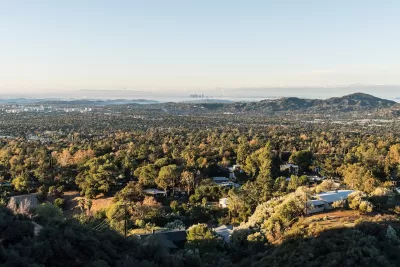The community has higher Black homeownership rates than most of Los Angeles, but now faces an uncertain future as residents struggle to rebuild.

Altadena, the center of one of January’s massively destructive wildfires in the Los Angeles area, was long a bastion of affordable and nondiscriminatory housing for Black families. “In past years, Altadena’s Black residents have had nearly double the homeownership rates of Black Americans across the Los Angeles county area – making the town a potential success story in efforts to shrink the racial wealth gap,” writes Lois Beckett in a piece for The Guardian.
Now, more than half of Altadena’s Black homeowners lost their homes, Beckett reports, putting residents at risk of displacement. According to an analysis by UCLA researchers, 61 percent of Altadena’s Black homes were within the Eaton Fire perimeter, and 48 percent of Black households were destroyed or majorly damaged.
The damage could eliminate decades of generational wealth built up by local families. The UCLA study also notes particular challenges that the Altadena community will face during recovery: more than half of Black homeowners are elderly, making them “especially vulnerable to incomplete or insufficient insurance coverage or predatory financial scams;” roughly 80 percent of Altadena homeowners are still paying off mortgages — on now-destroyed homes. Advocates are pressing for a 12-to-18-month mortgage deferment and a property tax freeze for affected families.
FULL STORY: California fires destroyed or damaged nearly half of Black homes in Altadena

Study: Maui’s Plan to Convert Vacation Rentals to Long-Term Housing Could Cause Nearly $1 Billion Economic Loss
The plan would reduce visitor accommodation by 25,% resulting in 1,900 jobs lost.

North Texas Transit Leaders Tout Benefits of TOD for Growing Region
At a summit focused on transit-oriented development, policymakers discussed how North Texas’ expanded light rail system can serve as a tool for economic growth.

Why Should We Subsidize Public Transportation?
Many public transit agencies face financial stress due to rising costs, declining fare revenue, and declining subsidies. Transit advocates must provide a strong business case for increasing public transit funding.

How to Make US Trains Faster
Changes to boarding platforms and a switch to electric trains could improve U.S. passenger rail service without the added cost of high-speed rail.

Columbia’s Revitalized ‘Loop’ Is a Hub for Local Entrepreneurs
A focus on small businesses is helping a commercial corridor in Columbia, Missouri thrive.

Invasive Insect Threatens Minnesota’s Ash Forests
The Emerald Ash Borer is a rapidly spreading invasive pest threatening Minnesota’s ash trees, and homeowners are encouraged to plant diverse replacement species, avoid moving ash firewood, and monitor for signs of infestation.
Urban Design for Planners 1: Software Tools
This six-course series explores essential urban design concepts using open source software and equips planners with the tools they need to participate fully in the urban design process.
Planning for Universal Design
Learn the tools for implementing Universal Design in planning regulations.
City of Santa Clarita
Ascent Environmental
Institute for Housing and Urban Development Studies (IHS)
City of Grandview
Harvard GSD Executive Education
Toledo-Lucas County Plan Commissions
Salt Lake City
NYU Wagner Graduate School of Public Service





























